THE SCIENTIFIC MONTHLY
—
OCTOBER, 1915
—
THE EVOLUTION OF THE STARS AND THE FORMATION
OF THE EARTH. II
BY DR. WILLIAM WALLACE CAMPBELL
DIRECTOR OF THE LICK OBSERVATORY, UNIVERSITY OF CALIFORNIA
THE PRINCIPLES OF SPECTROSCOPY
THUS far our description of the stellar universe has been confined to
its geometrical properties. A serious study of the evolution of the
stars must seek to determine, first of all, what the stars really are, what
their chemical constitutions and physical conditions are; and how they
are related to each other as to their physical properties. The application
of the spectroscope has advanced our knowledge of the subject by
leaps and bounds. This wonderful instrument, assisted by the photographic
plate, enables every visible celestial body to write its own record
of the conditions existing in itself, within limits set principally by the
brightness of the body. Such records physicists have succeeded to some
extent in duplicating in their laboratories; and the known conditions
under which the laboratory experiments have been conducted are the
Rosetta Stones which are enabling us to interpret, with more or less
success, the records written by the stars.
It is well known that the ordinary image of a star, whether formed
by the eye alone, or by the achromatic telescope and the eye combined,
contains light of an infinite variety of colors corresponding, speaking
according to the mechanical theory of light, to waves of energy of an
infinite variety of lengths which have traveled to us from the star.
In the point image of a star, these radiations fall in a confused heap.
and the observer is unable to say that radiations corresponding to any
given wave-lengths are present or absent. When the star's light has
been passed through the prism, or diffracted from the grating of a
spectroscope, these rays are separated one from another and arranged
side by side in perfect order, ready for the observer to survey them
and to determine which ones are present in superabundance and which
other ones are lacking wholly or in part. The following comparison
is a fair one: the ordinary point image of a star is as if all the books
in the university library were thrown together in a disorderly but compact
pile in the center of the reading room: we could say little concerning
the contents and characteristics of that library; whether it is
strong in certain fields of human endeavor, or weak in other fields.
The spectrum of a star is as the same library when the books are
arranged on the shelves in complete perfection and simplicity, so that
he who looks may appraise its contents at any or all points. Let us
consider the fundamental principles of spectroscopy.
1. When a solid body, a liquid, or
a highly-condensed gas is heated
to incandescence, its light when passed through a spectroscope forms a
continuous spectrum: that is, a band of light, red at one end and
violet at the other, uninterrupted by either dark or bright lines.
2. The light from the incandescent gas or vapor of a chemical
element,
passed through a spectroscope, forms a bright-line spectrum;
that is, one consisting entirely of isolated bright lines, distributed
differently throughout the spectrum for the different elements, or of bright
lines superimposed upon a relatively faint continuous spectrum.
3. If radiations from a continuous-spectrum source pass through
cooler gases or vapors before entering the spectroscope,
a dark-line
spectrum results: that is, the positions which the bright lines in the
spectra of the vapors and gases would have are occupied by dark or
absorption lines. These are frequently spoken of as Fraunhofer lines.
To illustrate: the gases and vapors forming the outer strata of the
Sun's atmosphere would in themselves produce bright-line spectra of the
elements involved. If these gases and vapors could in effect be removed,
without changing underlying conditions, the remaining condensed body
of the Sun should have a continuous spectrum. The cooler overlying
gases and vapors absorb those radiations from the deeper and hotter
sources which the gases and vapors would themselves emit, and thus
form the dark-line spectrum of the Sun. The stretches of spectrum
between the dark lines are of course continuous-spectrum radiations.
These principles are illustrated in Fig. 12. The essential parts of a
spectroscope are the slit—an opening perhaps 1/100th of an inch wide
and 1/10th of an inch long—to admit the light properly; a lens to
render the light rays parallel before they fall upon the prism or
grating; a prism or grating; a lens to receive the rays after they have
been dispersed by the prism or grating and to form an image of the
spectrum a short distance in front of the eye, where the eye will see
the spectrum or a sensitive dry-plate will photograph it. If we place
an alcohol lamp immediately in front of the slit and sprinkle some
common salt in the flame the two orange bright lines of sodium will be
seen in the eyepiece, close together, as in the upper of the two spectra
in the illustration. If we sprinkle thallium salt in the flame the green
line of that element will be visible in the spectrum. If we take the lamp
away and place a lime light or a piece of white-hot iron in front of
the slit we shall get a brilliant continuous spectrum not crossed by any
lines, either bright or dark. Insert now the alcohol-sodium-thallium
lamp between the lime light and the slit, and the observer will see the
two sodium lines and one thallium line in the same places as before,
but as dark lines on a background of bright continuous spectrum, as:
illustrated in the lower of the two spectra. Let us insert a screen between
the lamp and the lime light so as to cut out the latter, and we
shall see the bright lines of sodium and thallium reappear as in the
upper of the two spectra. These simple facts illustrate Kirchhoff's
immortal discovery of certain fundamental principles of spectroscopy,
in 1859. The gases and vapors in the lamp flame are at a lower
temperature than the lime source. The cooler vapors of sodium and
thallium have the power of absorbing exactly those rays from the
hotter lime or other similar source which the vapors by themselves would
emit to form bright lines.
When we apply the spectroscope to celestial objects we find apparently
an endless variety of spectra. We shall illustrate some of the
leading characteristics of these spectra as in Figs. 13 to 18, inclusive,
and Figs. 21, 22, 23 and 24. The spectra of some nebulæ consist almost
exclusively of isolated bright lines, indicating that these bodies consist
of luminous gases, as Huggins determined in 1864; but a very faint continuous
band of light frequently forms a background for the brilliant
bright lines. Many of the nebular lines are due to hydrogen, others
are due to helium; but the majority, including the two on the extreme
right in Fig. 13, which we attribute to the hypothetical element
nebulium, and the close pair on the extreme left, have not been matched
in our laboratories and, therefore, are of unknown origin. Most of the
irregular nebulæ whose spectra have been observed, the ring
nebulæ, the planetary and stellar nebulæ, have very similar
spectra, though with many differences in the
details.
[1]
The great spiral nebula in Andromeda has a continuous spectrum
crossed by a multitude of absorption lines. The spectrum is a very close
approach to the spectrum of our Sun. It is clear that this spiral nebula
is widely different from the bright-line or gaseous nebulæ in
physical condition. The spiral may be a great cluster of stars which are
approximate duplicates of our Sun, or there is a chance that it
consists, as Slipher has suggested, of a great central sun, or group of
suns, and of a multitude of small bodies or particles, such as meteoric
matter, revolving around the nucleus; this finely divided matter being
visible by reflected light which originates in the center of the system.
There is an occasional star, like η Carinæ, whose
spectrum consists almost wholly of bright lines, in general bearing no
apparent relationship to the bright lines in the spectra of the gaseous
nebulæ except that the hydrogen lines are there, as they are
almost everywhere. There is reason to believe that such a spectrum
indicates the existence of a very extensive and very hot atmosphere
surrounding the main body, or core, of the star in question. This
particular star is remarkable in that it has undergone great changes in
brilliancy and is located upon a background of nebulosity. The chances
are strong that the star has rushed through the nebulosity with high
rate of speed and that the resulting bombardment of the star has
expanded and intensely heated its atmosphere.
There are the Wolf-Rayet stars, named from the French astronomers
who discovered the first three of this class, whose spectra show a great
variety of combinations of continuous spectrum and bright bands. We
believe that the continuous spectrum in such a star comes from the more
condensed central part, or core, and that the bright-line light proceeds
from a hot atmosphere extending far out from the core.
The great majority of the stars have spectra which are
continuous, except for the presence of dark or absorption lines: a few
lines in the very blue stars, and an increasing number of lines as we
pass from the blue through the yellow and red stars to those which are
extremely red.
Secchi in the late 60's classified the spectra of
the brighter stars, according to the absorption lines in their spectra,
into Types I, II III and IV, which correspond: Type I, to the very blue
stars, such as
Spica and Sirius; Type II, to the yellow stars similar to our Sun;
Type III, to the red stars such as Aldebaran; and Type IV, to
the extremely red stars, of which the brightest representatives are near
the limit of naked-eye vision. Secchi knew little or nothing concerning
stars whose spectra contain bright lines, except as to the isolated
bright-line spectra of a few nebulæ, and as to the bright hydrogen lines
in γ Cassiopeia, and his system did not include these.
One of the most comprehensive investigations ever undertaken by
a single institution was that of classifying the stars as to their spectra,
over the entire sky, substantially down to and including the stars of
eighth magnitude, by the Harvard College Observatory, as a memorial
to the lamented Henry Draper. Professor Pickering and his associates
have formulated a classification system which is now in universal use.
It starts with the bright-line nebulæ, passes to the bright-line stars,
and then to the stars in which the helium absorption lines are prominent.
The latter are called the helium stars, or technically the Class B
stars. The next main division includes the stars in which hydrogen
absorption is prominent, called Class A. Classes B and A are blue
stars. Then follows in succession Class F, composed of bluish-yellow
stars, which is in a sense a transition class between the hydrogen stars
and those resembling our Sun, the latter called Class G. The Class G
stars are yellow. Class K stars are the yellowish-red; Class M, the red;
and Class N, the extremely red. Each of these classes has several
subdivisions which make the transition from one main class to the next
main class fairly gradual, and not per saltum; though it should be said
that the relationship of Class N to Class M spectra is not clear. The
illustration, Fig. 17, brings out the principal features of the spectra of
Classes B to M. The spectrum becomes more complicated as we pass
from Class B to the Class M, and the color changes from blue to extreme
red, because the violet and blue radiations become rapidly weaker
as we pass through the various classes.
GENERAL COURSE OF EVOLUTIONARY PROCESS
The general course of the evolutionary processes as applied to the
principal classes of celestial bodies is thought to be fairly well known.
With very few exceptions astronomers are agreed as to the main trend
of this order, but this must not be interpreted to mean that there are
no outstanding differences of opinion. There are, in fact, some items
of knowledge which seem to run counter to every order of evolution
that has been proposed.
The large irregular nebulæ, such as the great nebula in
Orion, the Trifid nebula, and the background of nebulosity which
embraces a large part of the constellation of Orion, are thought to
represent the earliest form of inorganic life known to us. The material
appears to
be in a chaotic state. There is no suggestion of order or system. The
spectroscope shows that in many cases the substance consists of glowing
gases or vapors; but whether they are glowing from the incandescence
resulting from high temperature, or electrical condition, or
otherwise, is unknown, though heat origin of their light is the simplest
hypothesis now available. Whether such nebulæ are originally hot or
cold, we must believe that they are endowed with gravitational power,
and that their molecules or particles are, or will ultimately be, in motion.
It will happen that there are regions of greater density, or nuclei,
here and there throughout the structure which will act as centers of
condensation, drawing surrounding materials into combination with
them. The processes of growth from nuclei originally small to volumes
and masses ultimately stupendous must be slow at first, relatively more
rapid after the masses have grown to moderate dimensions and the supplies
of outlying materials are still plentiful, and again slow after the
supplies shall have been largely exhausted. By virtue of motions prevailing
within the original nebular structure, or because of inrushing
materials which strike the central masses, not centrally but obliquely,
low rotations of the condensed nebulous masses will occur. Stupendous
quantities of heat will be generated in the building-up process.
This heat will radiate rapidly into space because the gaseous masses
are highly rarefied and their radiating surfaces are large in proportion
to the masses. With loss of heat the nebulous masses will contract
in volume and gradually assume forms more and more spherical.
When the forms become approximately spherical, the first stage of
stellar life may be said to have been reached.
It was Herschel's belief that by processes of condensation, following
the loss of heat by radiation into surrounding space, formless
nebulæ gravitated into nebulæ of smaller and smaller volumes until
finally the planetary form was reached, and that planetaries were the
ancestors of stars in general. That the planetaries do develop into stars,
we have every reason to believe; but that all nebulæ, or relatively many
nebulæ, pass through the planetary stage, or that many of our stars
have developed from planetaries, we shall later find good reason for doubting.
The probabilities are immensely stronger that the stars in general
have been formed directly from the irregular nebulæ, without the
intervention of the planetaries. The planetary nebulæ seem to be
exceptional cases, but to this point we shall return later.
It is quite possible, and even probable, that gaseous masses have
not in all cases passed directly to the stellar state. The materials in a
gaseous nebula may be so highly attenuated, or be distributed so irregularly
throughout a vast volume of space, that they will condense into
solids, small meteoric particles for example, before they combine to
form stars. Such masses or clouds of non-shining or invisible matter
are thought to exist in considerable profusion within the stellar system.
The nebulosity connected more or less closely with the brighter Pleiades
stars may be a case in illustration. Slipher has recently found that
the spectra of two small regions observed in this nebula are continuous,
with absorption lines of hydrogen and helium. This spectrum is apparently
the same as that of the bright Pleiades stars. Slipher's interpretation
is that the nebula is not shining by its own light, but is reflecting
to us the light of the Pleiades stars. That this material will
eventually be drawn into the stars already existing in the neighborhood,
or be condensed into new centers and form other stars, we can scarcely
doubt. The condensation of such materials to form stars large enough
to be seen from the great distance of the Pleiades cluster must generate
heat in the process, and cause these stars in their earliest youth to be
substantially as hot as other stars formed directly from gaseous materials.
It is possible, also, that the spiral nebulæ will develop into
stars, perhaps each such object into many, or some of the larger ones
into multitudes, of stars.
Let us attempt to visualize the conditions which we think exist in a
newly-formed star of average mass. It should be essentially spherical,
with surface fairly sharply defined. Our Sun has average specific gravity
of 1.4, as compared with that of water. The average density of the
very young star must certainly be vastly lower; perhaps no greater
than the density of our atmosphere at the Earth's surface; it may even
be considerably lower than this estimate. The diameter of our Sun is
1,400,000 kilometers. The diameter of the average young star may be
ten or twenty or forty times as great. The central volume or core
of the star is undoubtedly a great deal denser than the surface strata,
on account of pressure due to the star's own gravitational forces. The
conditions in the outer strata should bear some resemblance to those
existing in the gaseous nebula. The star may or may not have a corona
closely or remotely similar to our Sun's corona. The deep interior of
the star must be very hot, though not nearly so hot as the interiors of
older stars; but the surface strata of the young star should be remarkably
hot; for, being composed of highly attenuated gases, any lowering
of the temperature by radiation into surrounding space will be
compensated promptly through the medium of highly-heated convection
currents which can travel more rapidly from the interior to the surface
than in the case of stars in middle or old age. Even though the star,
as observed in our most powerful telescopes, is a point of light, without
apparent diameter, its outer strata should supply some bright lines in
the spectrum, because these strata project out beyond what we may
call the core of the star and themselves act as sources of light. The
spectrum should, therefore, consist of some of the bright lines which
were observed in the nebular spectrum, these proceeding from the
outer strata of the star; and of a continuous spectrum made up of radiations
proceeding from the deeper strata or core of the star, in which a
few dark lines may be introduced by the absorption from those parts of
the outer gaseous strata which lie between us and the core.
A few hundred stellar spectra resembling this description are well
known, discovered mostly at the Harvard Observatory. Their details
differ greatly, but they have certain features in common. The bright
lines of helium are extremely rare in stars, but they have been observed
in a few stellar spectra. The bright lines of nebulium have never
been observed in a true star: they and the radiations in the ultra-violet
known as at 3726A, seem to be confined to the nebular state; and the
absorption lines of nebulium have never been observed in any spectrum.
As soon as the stellar state is reached nebulium is no longer in evidence.
Stellar spectra containing bright lines seem always to include
hydrogen bright lines. This is as we should expect; hydrogen is the
lightest known gas, and it is probably the substance which can best
exist in the outer strata of stars in general. The extensive outer strata
of very young stars seem to be composed largely of hydrogen, though
other elements are in some cases present, as indicated by the weaker
bright lines in a few cases. This preference of hydrogen for the outermost
strata is illustrated by several very interesting observations of the
nebulæ. The nebulium lines are relatively strong in the central denser
parts of the Orion and Trifid nebulæ, but the hydrogen bright-lines are
relatively very strong in the faint outlying parts of these nebulæ. The
planetary nebula B.D.—12°.1172 is seen in the ordinary telescope
to consist of a circular disc (probably a sphere or spheroid) of light and
a faint star in its center. When this nebula is observed with a slitless
spectrograph the hydrogen and nebulium components are seen as circular
discs, but the hydrogen discs are larger than the nebulium discs. In
other words, the hydrogen forms an atmosphere about the central star
which extends out into space in all directions a great deal farther than
the nebulium discs extend. The Wolf-Rayet star-planetary nebula D.
M. + 30°.3639 looks hazy in a powerful telescope, and when examined
in a spectroscope the haziness is seen to be due to a sharply defined
globe of hydrogen 5 seconds of arc in diameter surrounding the star
in its center. Wolf and Burns have shown that in the Ring Nebula
in Lyra the 3726A and the hydrogen images are larger as to outer
diameter than the nebulium images, but that the latter are the more
condensed on the inner edge of the ring. Wright has in the present
year examined these and other nebulæ with special reference to the
distribution of the principal ingredients. He finds in general that the
radiations at 4363A and 4686A, of unknown or possibly helium origin,
are most closely compressed around the central nuclei of nebulæ; that
the matter definitely known to be helium is more extended in size;
that the nebulium structure is still larger; and that the hydrogen uniformly
extends out farther than the nebulium; and that the ultra violet
radiation at 3726A seems to proceed from the largest volume of all.
The 37726A line, like the nebulium line, is unknown in stellar spectra;
it seems also to be confined to true nebulosity. Neglecting the elements
which have never been observed in true stars, we may say that all these
observations are in harmony with the view that hydrogen should be and
is the principal element in the outer stratum of the very young star.
A few of the stars whose spectra contain bright hydrogen lines have
also a number of bright lines whose chemical origin is not known.
They appear to exist exactly at this state of stellar life: several of
them have not been found in the spectra of the gaseous nebulæ, and
they are not represented in the later types of stellar spectra. The strata
which produce these bright lines are thought to be a little deeper in the
stars than the outer hydrogen stratum.
A slightly older stage of stellar existence is indicated by the type of
spectrum in which some of the lines of hydrogen, always those at the
violet end, are dark, and the remaining hydrogen lines, always those
toward the red end, are bright. The brightest star in the Pleiades
group, Alcyone, presents apparently the last of this series, for all of
the hydrogen lines are dark except Hα, in the red. In some of the
bright-line stars which we have described, technically known as Oe5,
Harvard College Observatory found that the dark helium and hydrogen
lines exist, and apparently increase in intensity, on the average, as
the bright lines become fainter. Wright has observed the absorption
lines of helium and hydrogen in the spectra of the nuclei of some
planetary nebulæ, although the helium and hydrogen lines are bright
in the nebulosity surrounding the nuclei. We may say that when all
of the bright lines have disappeared from the spectra of stars, the
helium lines, and likewise the hydrogen lines, have in general become
fairly conspicuous. These stars are known as the helium stars, or stars
of Class B. Proceeding through the subdivisions of Class B, the
helium lines increase to a maximum of intensity and then decrease.
The dark hydrogen lines are more and more in evidence, with intensities
increasing slowly. In the middle and later subdivisions of the
helium stars silicon, oxygen and nitrogen are usually represented by a
few absorption lines.
Just as the gaseous nebulæ radiate heat into space and condense,
so must the stars, with this difference: the nebulæ are highly rarified
bodies, with surfaces enormously large in proportion to the heat contents;
and the radiation from them must be relatively rapid. In fact,
some of the nebulæ seem to be so highly rarified that radiation may
take place from their interiors almost as well as from their surfaces.
The radiation from a star just formed must occur at a much slower
rate. The continued condensation of the star, following the loss of
heat, must lead to a change of physical condition, which will be apparent
in the spectrum. It should pass from the so-called helium
group, to the hydrogen, or Class A group, not suddenly but by insensible
gradations of spectrum. In the Class A stars the hydrogen lines
are the most prominent features. The helium lines have disappeared,
except in a few stars where faint helium remnants are in evidence.
The magnesium lines have become prominent and the calcium lines
are growing rapidly in strength. The so-called metallic lines, usually
beginning with iron and titanium lines, which have a few extremely
faint representatives in the last of the helium stars, become visible
here and there in the Class A spectra, but they are not conspicuous.
In the next main division, the Class F spectra, the metallic lines
increase rapidly in prominence, and the hydrogen lines decrease slightly
in strength. These stars are not so blue as the helium and hydrogen
stars. They are intermediate between the blue stars and the yellow
stars, which begin with the next class, G, of which our Sun is a
representative.
The metallic lines are in Class G spectra in great number and
intensity, and the hydrogen lines are greatly reduced in prominence.
The calcium bands are very wide and intense.
Another step brings us to the very yellow and the slightly-reddish
stars, known as Class K. These stars are weak in violet light, the
hydrogen lines are substantially of the same intensity as the most prominent
metallic lines, and the metallic lines are more and more in evidence.
Stars in the last subdivisions of the Class K and all of the Class M
stars are decidedly red. In these the hydrogen lines are still further
weakened and the metallic lines are even more prominent. Their
spectra are further marked by absorption bands of titanium oxide,
which reach their maximum strength in the later subdivisions of
Class M.
The extremely red stars compose Class N on the Harvard scale.
Their spectra are almost totally lacking in violet light, the metallic
absorption is very strong, and there are conspicuous absorption bands
of carbon.
Deep absorbing strata of titanium and carbon oxides seem to exist
in the atmospheres of the Class M and N stars, respectively. The presence
of these oxides indicates a relatively low temperature, and this is
what we should expect from stars so far advanced in life.
The period of existence succeeding the very red stars has illustrations
near at hand, we think, in Jupiter, Saturn, Uranus and Neptune,
and in the Earth and the other small planets and the Moon: bodies
which still contain much heat, but which are invisible save by means
of reflected light.
The progression of stellar development, which we have described,
has been based upon the radiation of heat. This is necessarily gradual,
and the corresponding changes of spectrum should likewise be gradual
and continuous. It is not intended to give the impression that only a
few types of spectra are in evidence: the variety is very great. The
labels, Class B, Class A, and so on to Class N, are intended to mark
the miles in the evolutionary journey. The Harvard experts have put
up other labels to mark the tenths of miles, so to speak, and some day
we shall expect to see the hundredths labeled. Further, it is not here
proposed that heat radiation is the only vital factor in the processes of
evolution. The mass of a star may be an important item, and the
electrical conditions may be concerned. A very small star and a very
massive star may develop differently, and it is conceivable that there
may be actual differences of composition. But heat-radiation is doubtless
the most important factor.
The evolutionary processes must proceed with extreme deliberation.
The radiation of the heat actually present at any moment in a large
helium star would probably not require many tens of thousands of years,
but this quantity of heat is negligible in comparison with the quantity
generated within the star during and by the processes of condensation
from the helium age down to the Class M state. We know that the
compression of any body against resistance generates or releases heat.
Now a gaseous star at any instant is in a state of equilibrium. Its
internal heat and the centrifugal force due to its rotation about an axis
are trying to expand it. Its own gravitational power is trying to draw
all of its materials to the center. Until there is a loss of heat no
contraction can occur; but just as soon as there is such a loss gravity
proceeds to diminish the stellar volume. Contraction will proceed more
slowly than we should at first thought expect, because in the process of
contraction additional heat is generated and this becomes a factor in
resisting further compression. Contraction is resisted vastly more by
the heat generated in the process of contraction than it is by the store
of heat already in evidence. The quantity of heat in our Sun, now
existing as heat, would suffice to maintain its present rate of outflow
only a few thousands of years. The heat generated in the process of
the Sun's shrinkage under gravity, however, is so extensive as to maintain
the supply during millions of years to come. Helmholtz has shown
that the reduction of the Sun's radius at the rate of 45 meters per year
would generate as much heat within the Sun as is now radiated. This
rate of shrinkage is so slow that our most refined instruments could
not detect a change in the solar diameter until after the lapse of 4,000
or 5,000 years. Again, there are reasons for suspecting that the processes
of evolution in our Sun, and in other stars as well, may be enormously
prolonged through the influence of energy within the atoms or
molecules of matter composing them. The subatomic forces residing
in the radioactive elements represent the most condensed form of energy
of which we have any conception. It is believed that the subatomic
energy in a mass of radium is at least a million-fold greater than
the energy represented in the combustion or other chemical transformation
of any ordinary substance having the same mass. These radioactive
forces are released with extreme slowness, in the form of heat or
the equivalent; and if these substances exist moderately in the Sun and
stars, as they do in the Earth, they may well be important factors in
prolonging the lives of these bodies.
Speaking somewhat loosely, I think we may say that the processes
of evolution from an extended nebula to a condensed nebula and from
the latter to a spherical star, are comparatively rapid, perhaps normally
confined to a few tens of millions of years; but that the further we proceed
in the development process, from the blue star to the yellow, and
possibly but not certainly on to the red star, the slower is the progress
made, for the radiating surface through which all the energy from the
interior must pass becomes smaller and smaller in proportion to the
mass, and the convection currents which carry heat from the interior
to the surface must slow down in speed.
[1.]
My colleague, Wright, who has been making a study of
the nebular spectra, has determined the accurate positions of about 67
bright nebular lines.
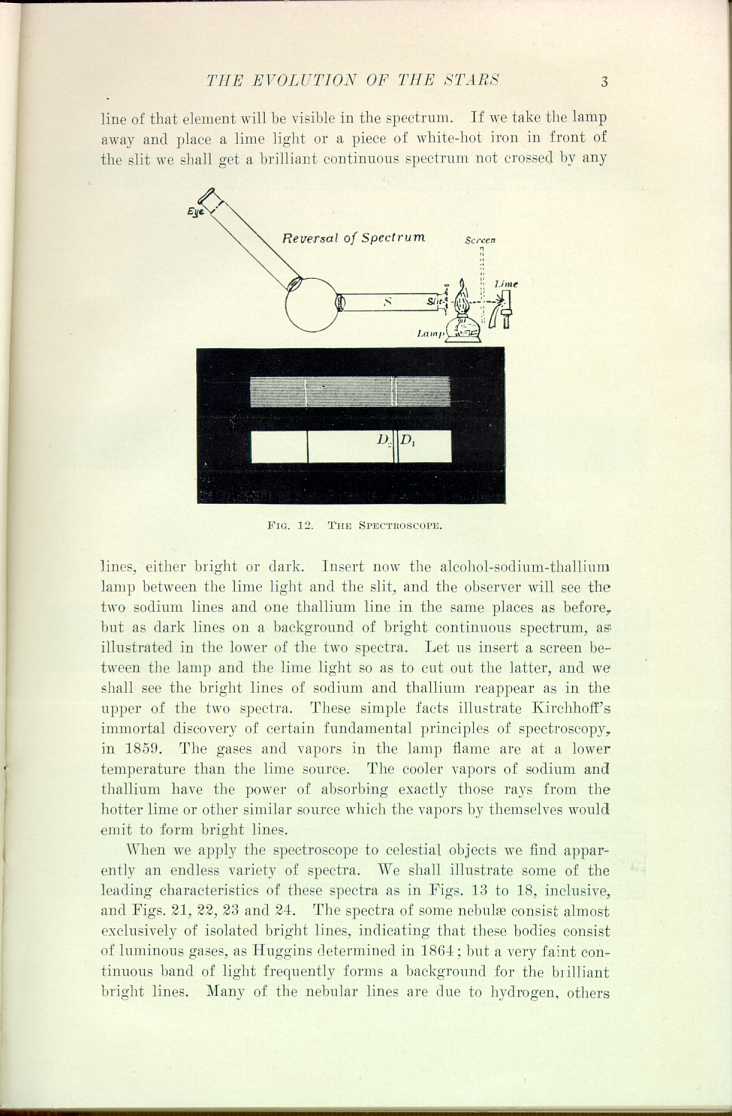
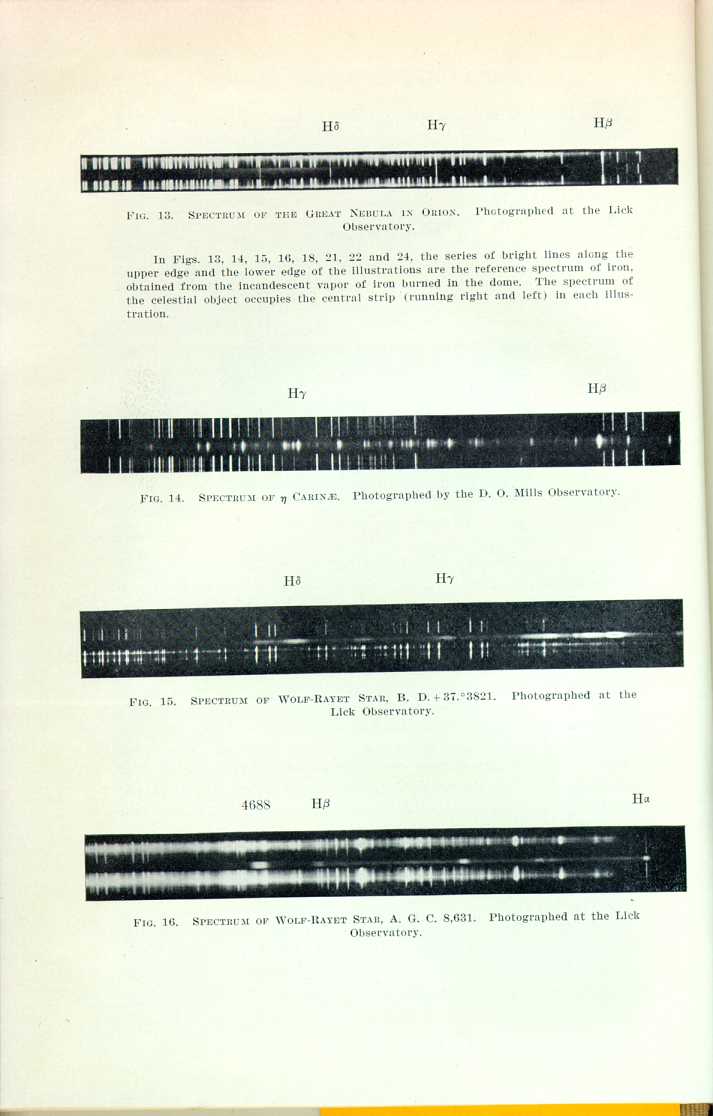
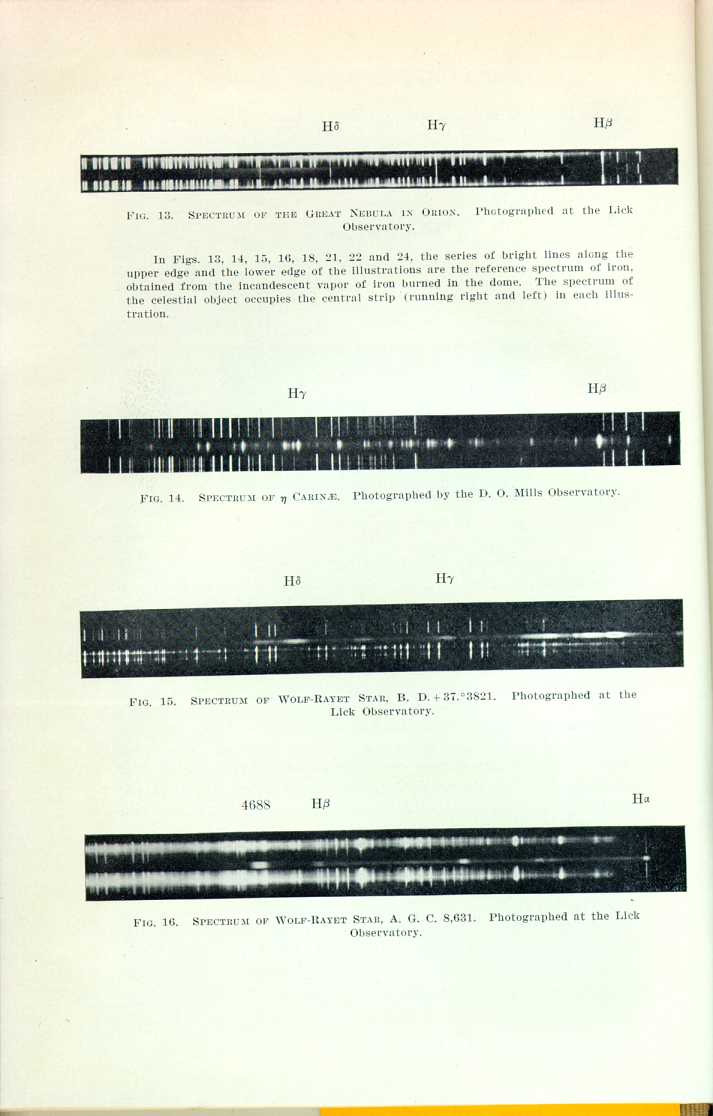
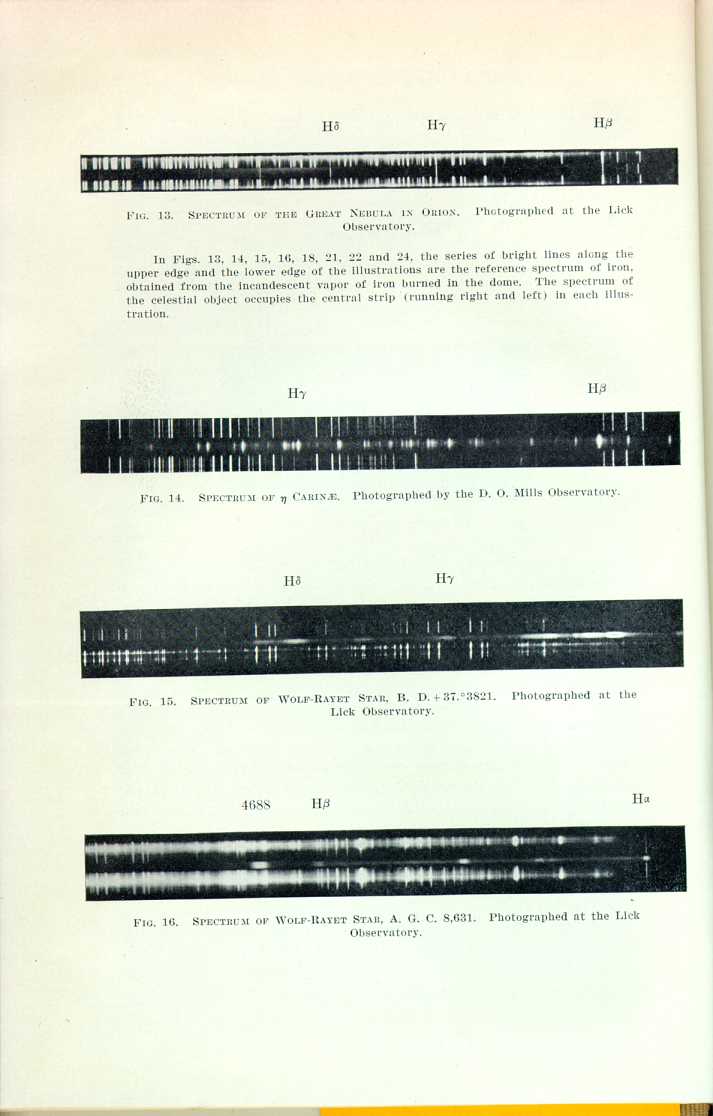
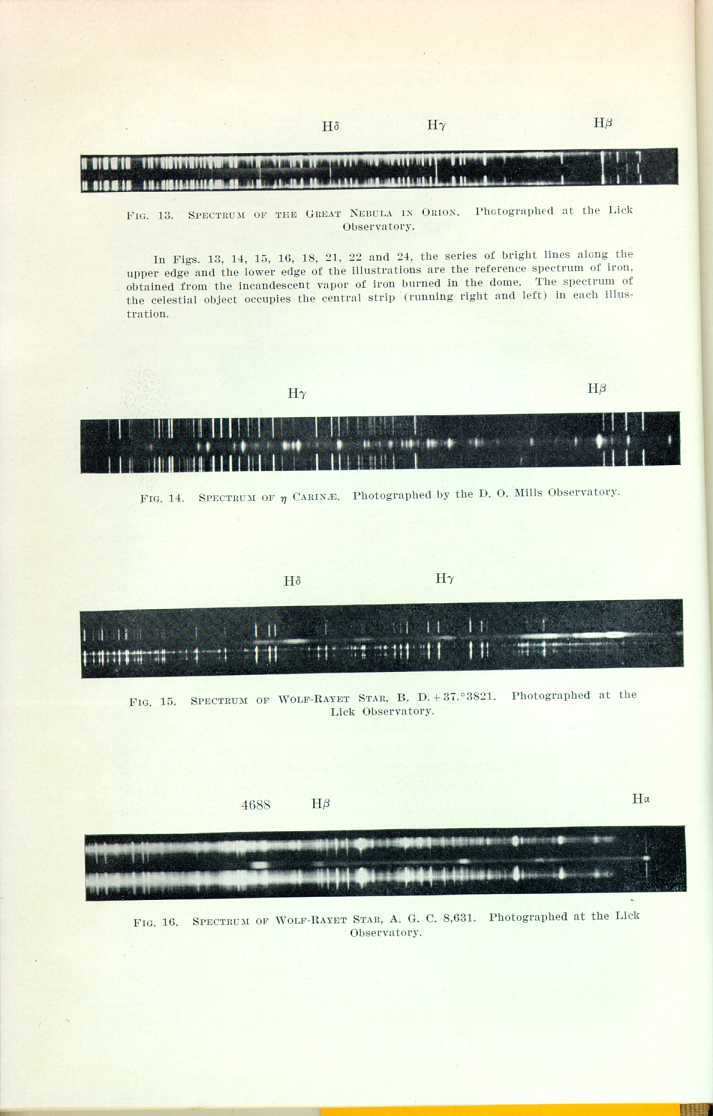
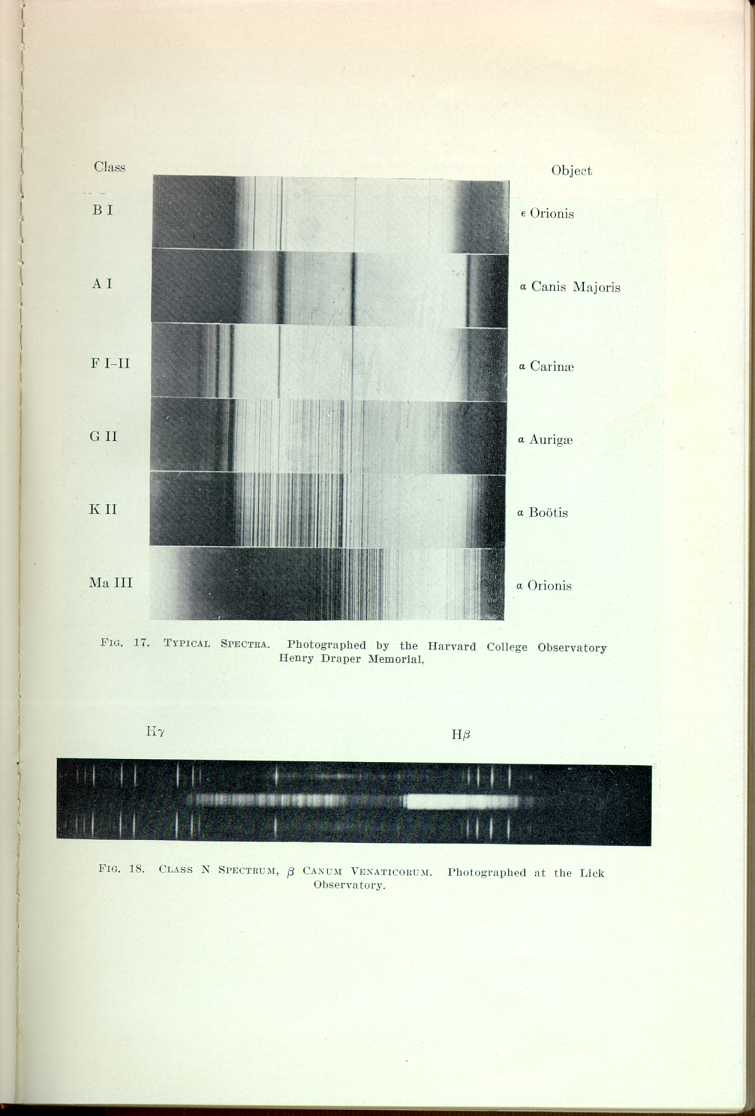
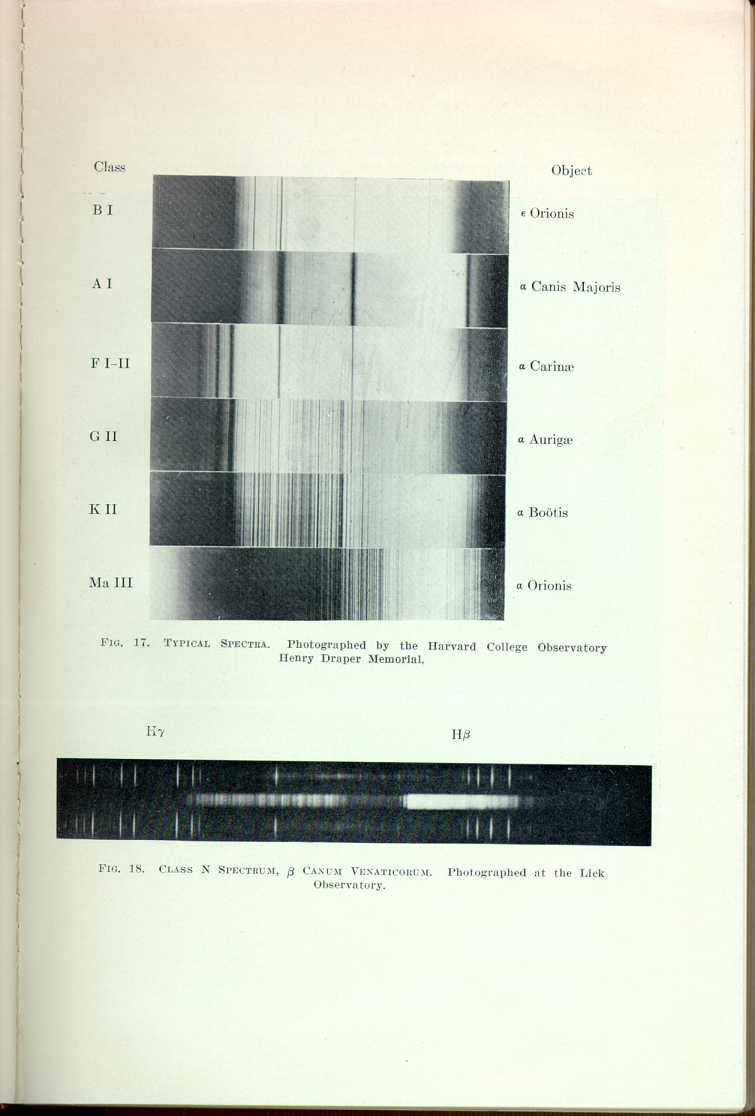
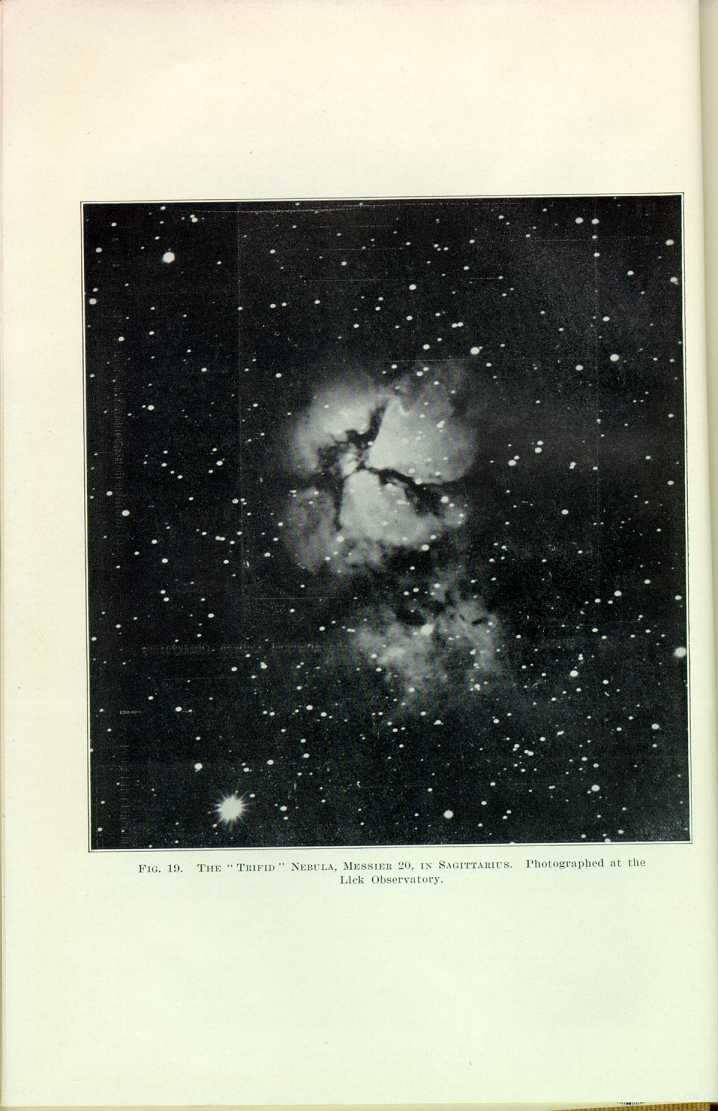
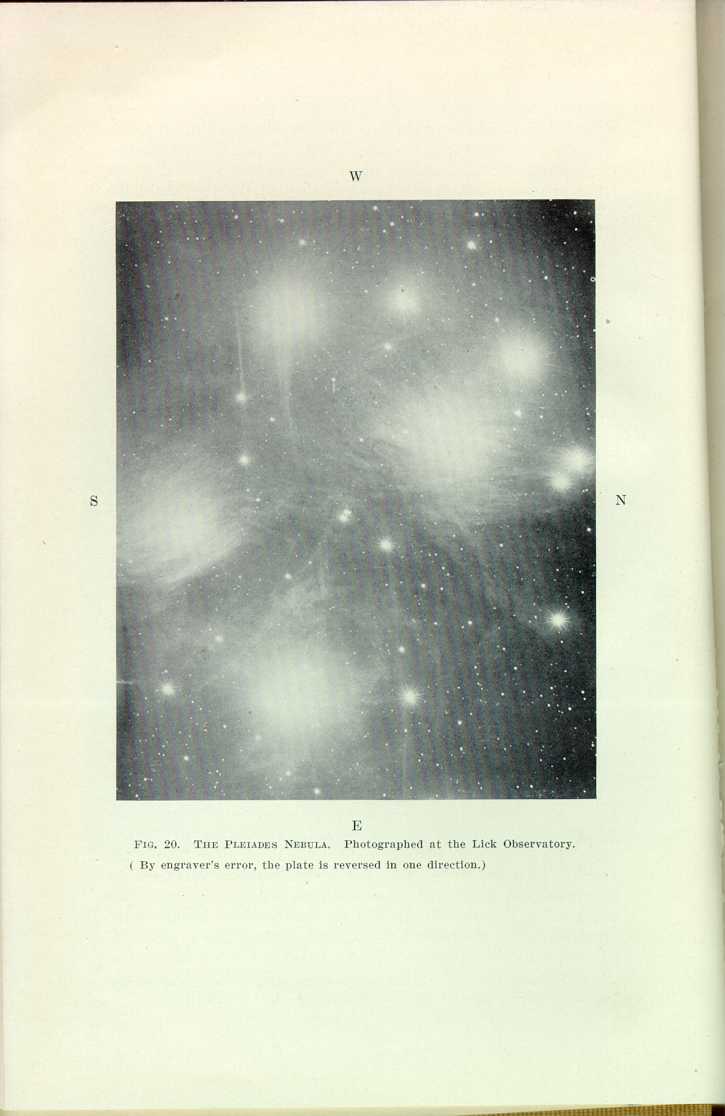
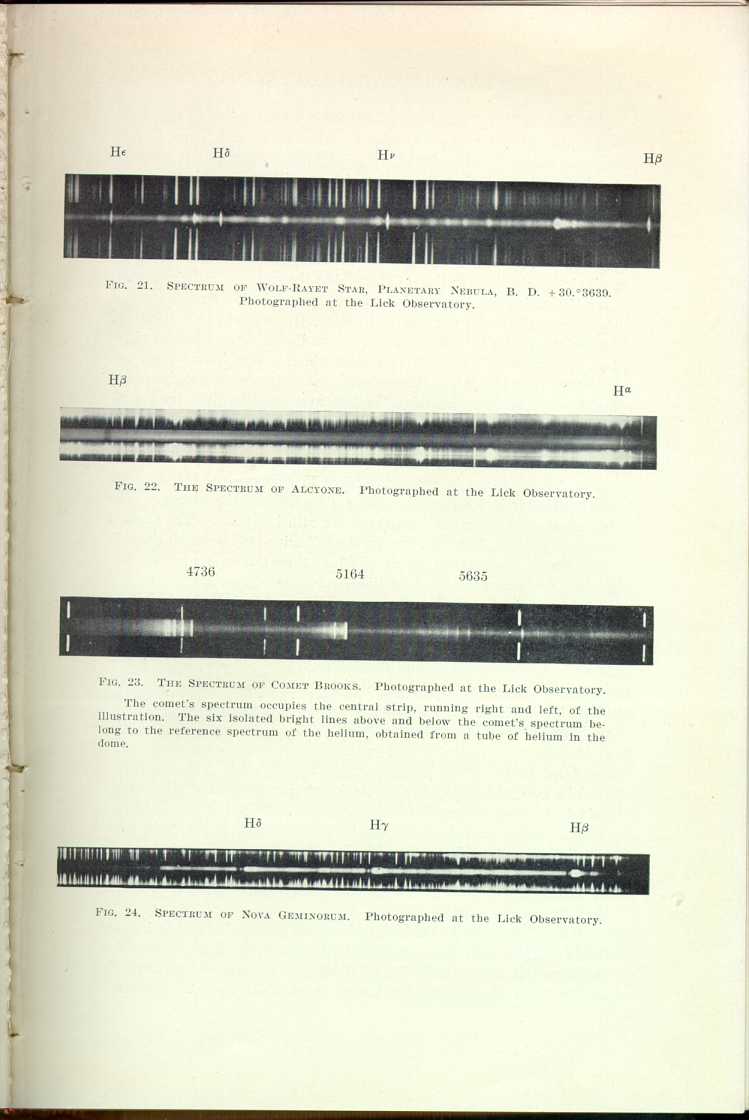
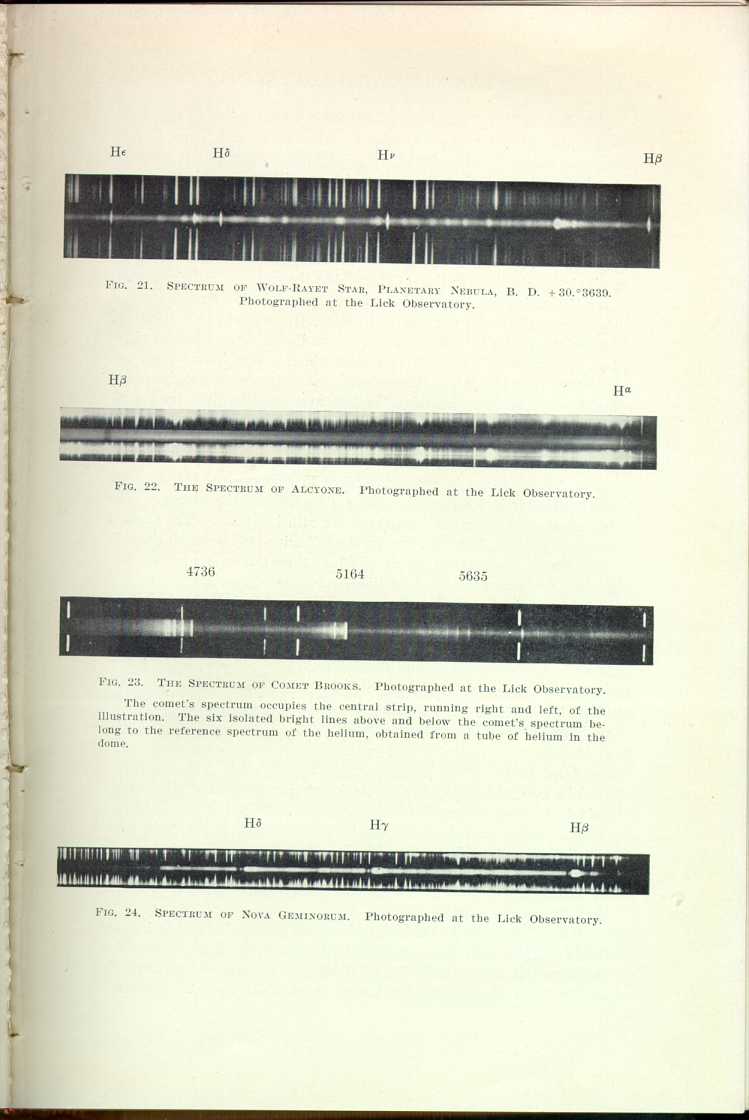
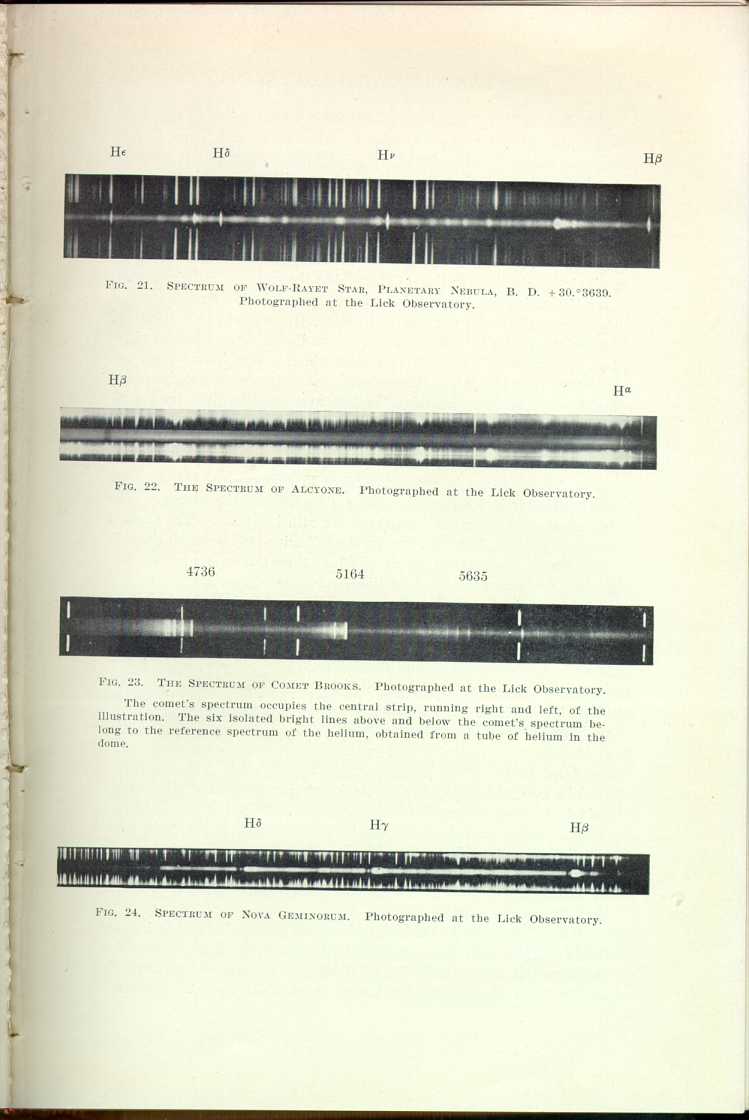
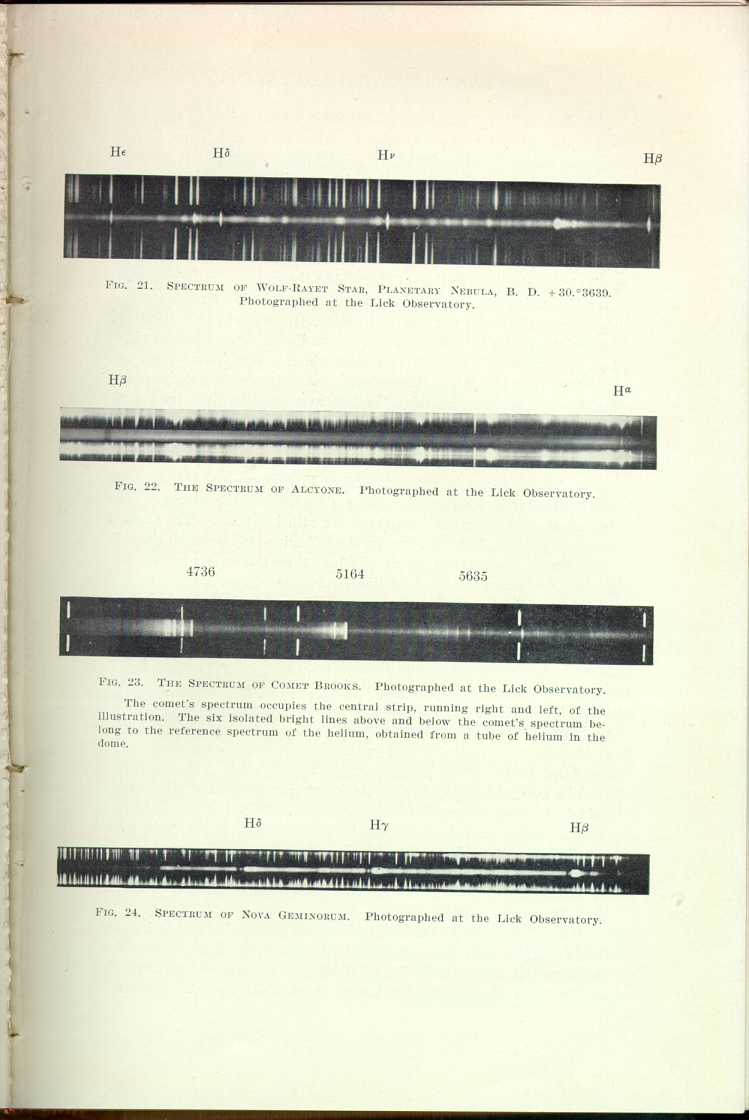 [Description: Four individual photographs of the spectra of four celestial
bodies. Essentially it is a long black horizontal photographic band
streaked vertically with white lines.]
[Description: Four individual photographs of the spectra of four celestial
bodies. Essentially it is a long black horizontal photographic band
streaked vertically with white lines.]